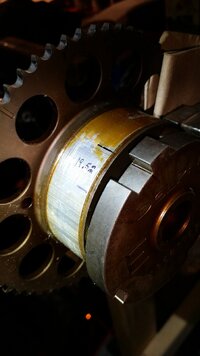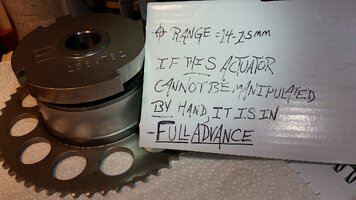Salutations Brothers Of The Wrench!!!
In completing a ****Finalized Comprehensive**** compilation of all influences directly relative to the Vortec 4200 L6 Engine VVT Variable Cam Phaser System, I found a wealth of knowledge deposited across the years within a number of forums, articles, and formal GM releases directly correlative to and updating all discussion and subtleties hidden within and surrounding this exceptionally complex system.
Beginning at timestamp 5:30, this video:
begins an original introduction of the variable cam phaser system incorporated *within* the exhaust cam sprocket as the:
"Exhaust Camshaft Position Actuator".
This integral component is the fundamental backbone of all valvetrain viability, vulnerability, and specialized DOHC timing retardation.
FINAL focus of the PCM's p.ulse-w.idth-m.odulated variability to valve overlap is tucked away in the hub, whereupon is found a:
Hydraulically Actuated Piston.
This piston is **first-feed-fed** by it's fundamentally integrated *neighbor* :
The Camshaft Position Actuator ***Solenoid***.
This solenoid -in- PRIMARY- PCM p.w.m. focus directs the CMP timing retardation based on hydraulic principle actuation.
From the GM Video:
"The piston has an internal helical spline that slides enmeshed with the gear, as the piston moves, the piston and gear mechanism changes the timing of the exhaust camshaft relative to the camdrive sprocket."
::::: PRIMARY FOCUS OF THIS POST :::::: :
--- "When oil pressure is applied to one side of the piston, the cam moves ^clockwise^, and timing is advanced." ---
--- "When oil pressure is applied to the other side of the piston, the cam moves *counter clockwise* to retard timing." ---
--- "The total range of camshaft phaser rotation is 25 camshaft degrees"---
Video Example at timestamp 7:17 :
--- "When the 4200 is at idle, the exhaust cam is in the fully advanced position...."
At this point in the video, using the exhaust camshaft HEX, the exhaust #camshaft# is rotated CLOCKWISE to demonstrate the:
"FULLY ADVANCED" position.
As the camshaft is rotated clockwise in the video, it can be clearly seen that the *ACTUATOR* outer ring/ front reluctor advances clockwise & *LOCKS* 99% independently of THE SPROCKET, and *ONLY BARELY MOVES* the cog orientation in the timing chain configuration as it locks in fully advanced orientation.
___________________________________________________________________
I'm writing this post to advance a cumulative response to the *GREY* area of what has been considered as a "fully advanced" phaser in the *viable configuration* of orientation, and to surgically remark on $ it's exacting finality $. @Mooseman & @mrrsm have both drawn excellent dissertations related to this subject, and I would state that both have described the exact nature of this component directly relative to the R&R of the timing system.
___________________________________________________________________
Relative to the:
2008 4.2L Manual (2005 & Onward 4 Vane Style Actuator)
PAGE 68,
CAMSHAFT POSITION ACTUATOR DIAGNOSIS
The camshaft position actuator will only phase 25-cam degrees retard(counterclockwise). Full advance clockwise is 0 degrees.
The camshaft position actuator should always be serviced/replaced in the full advanced position(full clockwise or 0 degrees).
$$$$$$$$$$$$$$$$$$$$$$$$$$$$$$$$$$$$$$$$$$$$$$$$$$$$$$$$$$$$$$$$$$$$$$$$$$$$$$$$$$$$
New replacement(service) camshaft position actuators are ^^^^^shipped at full advance or 0 degrees.
$$$$$$$$$$$$$$$$$$$$$$$$$$$$$$$$$$$$$$$$$$$$$$$$$$$$$$$$$$$$$$$$$$$$$$$$$$$$$$$$$$$$
To be sure the camshaft position actuator is performing properly, perform the following to help in the diagnostics.
The camshaft position actuator must be removed from the engine to perform the proper diagnostic test.
1. Clamp the camshaft actuator in a vise. Use care not to damage the contact area of the sprocket.
2. Scribe or draw a line on the camshaft position actuator outer ring face, in the full advanced position.
With the engine at TDC, on #1 cylinder, the wording should be level.
3. Apply compressed air pressure to the oil port(1) on the back side of the actuator to UNLOCK THE LOCKING PIN.
####808's Case Study Note:####
When applying compressed air to the rear oil port, it's obviously redundant to observe a rubber fitting at the source of air contact.
Subtlety at pressure activation:
Compressed air applied -will- slightly unlock the actuator, but without holding the actuator **FULLY ADVANCED** clockwise during ***initial*** application of compressed air, and then by turning to full counterclockwise position, only a minute degree of rotation was possibly achieved.
#########################
4.Turn the actuator, by hand, to the full counterclockwise position.
5.Scribe or draw a line on the camshaft position actuator at that position.
IMPORTANT: It is normal for oil and air to leak out of the camshaft actuator when compressed air is applied. It is also normal for oil bubbles to form on the camshaft sprocket surface due to porositY caused by the casting process. Do not replace the actuator due to this leakage.
6.Measure the distance between the two lines. The measurement should be 14-15mm (0.55-0.59 in).
++++The camshaft position actuator must be replaced IF: ++++++
IT DOES NOT UNLOCK WHEN AIR PRESSURE IS APPLIED,
DOES NOT LOCK WHEN AIR PRESSURE IS REMOVED,
OR DOES NOT MOVE WITHIN THE 14-15 mm(0.55-0.59)
++++++++++++++++++++++++++++++++++++++++++++
HEREIN CORRELATED WITH:
TSB 07-06-01-018A:
Vortec™ 4.2L I-6 Engine (VIN S — RPO LL8)
This bulletin is being revised to remove reference to the parts information. Please discard
Corporate Bulletin Number 07-06-01-018 (Section 06 — Engine/Propulsion System).
Engine Cylinder Head Installation, Step 4
Exhaust Camshaft Actuator Notice: The exhaust camshaft actuator must be fully advanced
during installation. Engine damage may occur if the camshaft actuator is not fully
advanced. Refer to Camshaft Position Actuator Diagnosis in SI.
########
With this Data Set,
The visual representations, written descriptions, and firsthand accounts all describe and directly indicate that:
the VVT Phaser, in a -locked- position, requires a hydraulically or pneumatically actuated stimulus to:
*UNLOCK*
from
* A FULLY ADVANCED POSITION OF 0° *
Thus, if the actuator is LOCKED, it is FULLY ADVANCED TO ZERO°.
Here follow 2 photos,
1st: The antiquated phaser of 185,000 miles of use, demonstrating worn cogs, 19.5mm of travel, inability to lock, and minor particulate expulsion from the vanes at the compressed air blast out.
2nd: Declarative Statement & "New" GM VVT Phaser - appropriated from the box *in dire straits* of strange powdered metal.


In completing a ****Finalized Comprehensive**** compilation of all influences directly relative to the Vortec 4200 L6 Engine VVT Variable Cam Phaser System, I found a wealth of knowledge deposited across the years within a number of forums, articles, and formal GM releases directly correlative to and updating all discussion and subtleties hidden within and surrounding this exceptionally complex system.
Beginning at timestamp 5:30, this video:
General Motors - 4200 Engine Familiarization
"Exhaust Camshaft Position Actuator".
This integral component is the fundamental backbone of all valvetrain viability, vulnerability, and specialized DOHC timing retardation.
FINAL focus of the PCM's p.ulse-w.idth-m.odulated variability to valve overlap is tucked away in the hub, whereupon is found a:
Hydraulically Actuated Piston.
This piston is **first-feed-fed** by it's fundamentally integrated *neighbor* :
The Camshaft Position Actuator ***Solenoid***.
This solenoid -in- PRIMARY- PCM p.w.m. focus directs the CMP timing retardation based on hydraulic principle actuation.
From the GM Video:
"The piston has an internal helical spline that slides enmeshed with the gear, as the piston moves, the piston and gear mechanism changes the timing of the exhaust camshaft relative to the camdrive sprocket."
::::: PRIMARY FOCUS OF THIS POST :::::: :
--- "When oil pressure is applied to one side of the piston, the cam moves ^clockwise^, and timing is advanced." ---
--- "When oil pressure is applied to the other side of the piston, the cam moves *counter clockwise* to retard timing." ---
--- "The total range of camshaft phaser rotation is 25 camshaft degrees"---
Video Example at timestamp 7:17 :
--- "When the 4200 is at idle, the exhaust cam is in the fully advanced position...."
At this point in the video, using the exhaust camshaft HEX, the exhaust #camshaft# is rotated CLOCKWISE to demonstrate the:
"FULLY ADVANCED" position.
As the camshaft is rotated clockwise in the video, it can be clearly seen that the *ACTUATOR* outer ring/ front reluctor advances clockwise & *LOCKS* 99% independently of THE SPROCKET, and *ONLY BARELY MOVES* the cog orientation in the timing chain configuration as it locks in fully advanced orientation.
___________________________________________________________________
I'm writing this post to advance a cumulative response to the *GREY* area of what has been considered as a "fully advanced" phaser in the *viable configuration* of orientation, and to surgically remark on $ it's exacting finality $. @Mooseman & @mrrsm have both drawn excellent dissertations related to this subject, and I would state that both have described the exact nature of this component directly relative to the R&R of the timing system.
___________________________________________________________________
Relative to the:
2008 4.2L Manual (2005 & Onward 4 Vane Style Actuator)
PAGE 68,
CAMSHAFT POSITION ACTUATOR DIAGNOSIS
The camshaft position actuator will only phase 25-cam degrees retard(counterclockwise). Full advance clockwise is 0 degrees.
The camshaft position actuator should always be serviced/replaced in the full advanced position(full clockwise or 0 degrees).
$$$$$$$$$$$$$$$$$$$$$$$$$$$$$$$$$$$$$$$$$$$$$$$$$$$$$$$$$$$$$$$$$$$$$$$$$$$$$$$$$$$$
New replacement(service) camshaft position actuators are ^^^^^shipped at full advance or 0 degrees.
$$$$$$$$$$$$$$$$$$$$$$$$$$$$$$$$$$$$$$$$$$$$$$$$$$$$$$$$$$$$$$$$$$$$$$$$$$$$$$$$$$$$
To be sure the camshaft position actuator is performing properly, perform the following to help in the diagnostics.
The camshaft position actuator must be removed from the engine to perform the proper diagnostic test.
1. Clamp the camshaft actuator in a vise. Use care not to damage the contact area of the sprocket.
2. Scribe or draw a line on the camshaft position actuator outer ring face, in the full advanced position.
With the engine at TDC, on #1 cylinder, the wording should be level.
3. Apply compressed air pressure to the oil port(1) on the back side of the actuator to UNLOCK THE LOCKING PIN.
####808's Case Study Note:####
When applying compressed air to the rear oil port, it's obviously redundant to observe a rubber fitting at the source of air contact.
Subtlety at pressure activation:
Compressed air applied -will- slightly unlock the actuator, but without holding the actuator **FULLY ADVANCED** clockwise during ***initial*** application of compressed air, and then by turning to full counterclockwise position, only a minute degree of rotation was possibly achieved.
#########################
4.Turn the actuator, by hand, to the full counterclockwise position.
5.Scribe or draw a line on the camshaft position actuator at that position.
IMPORTANT: It is normal for oil and air to leak out of the camshaft actuator when compressed air is applied. It is also normal for oil bubbles to form on the camshaft sprocket surface due to porositY caused by the casting process. Do not replace the actuator due to this leakage.
6.Measure the distance between the two lines. The measurement should be 14-15mm (0.55-0.59 in).
++++The camshaft position actuator must be replaced IF: ++++++
IT DOES NOT UNLOCK WHEN AIR PRESSURE IS APPLIED,
DOES NOT LOCK WHEN AIR PRESSURE IS REMOVED,
OR DOES NOT MOVE WITHIN THE 14-15 mm(0.55-0.59)
++++++++++++++++++++++++++++++++++++++++++++
HEREIN CORRELATED WITH:
TSB 07-06-01-018A:
Vortec™ 4.2L I-6 Engine (VIN S — RPO LL8)
This bulletin is being revised to remove reference to the parts information. Please discard
Corporate Bulletin Number 07-06-01-018 (Section 06 — Engine/Propulsion System).
Engine Cylinder Head Installation, Step 4
Exhaust Camshaft Actuator Notice: The exhaust camshaft actuator must be fully advanced
during installation. Engine damage may occur if the camshaft actuator is not fully
advanced. Refer to Camshaft Position Actuator Diagnosis in SI.
########
With this Data Set,
The visual representations, written descriptions, and firsthand accounts all describe and directly indicate that:
the VVT Phaser, in a -locked- position, requires a hydraulically or pneumatically actuated stimulus to:
*UNLOCK*
from
* A FULLY ADVANCED POSITION OF 0° *
Thus, if the actuator is LOCKED, it is FULLY ADVANCED TO ZERO°.
Here follow 2 photos,
1st: The antiquated phaser of 185,000 miles of use, demonstrating worn cogs, 19.5mm of travel, inability to lock, and minor particulate expulsion from the vanes at the compressed air blast out.
2nd: Declarative Statement & "New" GM VVT Phaser - appropriated from the box *in dire straits* of strange powdered metal.


Last edited:

